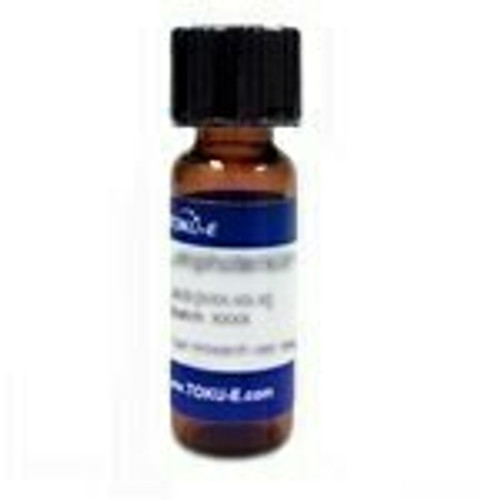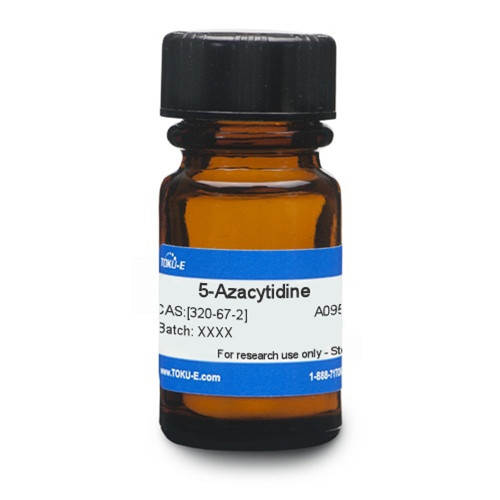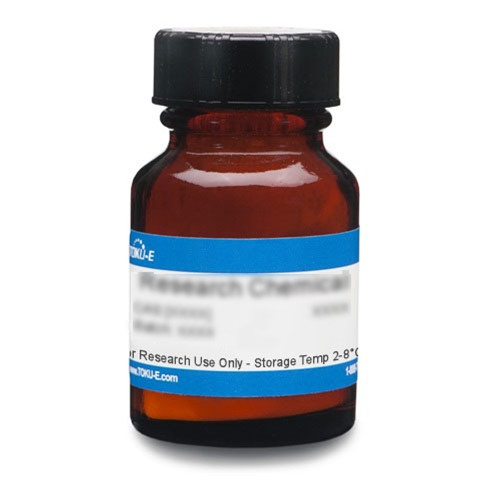5-Fluorocytosine (syn. Flucytosine) is a fluorinated cytosine (pyrimidine) analog with antifungal activity. First developed in 1957, it is active against Candida and Cryptococcus and is a competitive inhibitor of uracil metabolism. 5-Fluorocytosine is taken up by the fungus and is converted to the cytostatic 5-fluorouracil by cytosine deaminase. 5-Fluorocytosine can also be used in brain tumor research models using the virus Toca 511 which codes for cytosine deaminase. 5-Fluorocytosine is sparingly soluble in water.
| Mechanism of Action | 5-Fluorocytosine is taken up by the fungus and is deaminated by cytosine deaminase (CD) and converted to the cytostatic 5-fluorouracil (5-FU). During transcription, the pyrimidine analog is incorporated into the RNA which inhibits subsequent rounds of transcription and building of certain essential proteins.
An additional mechanism of action involves the conversion of 5-Fluorocytosine to 5-fluorodeoxyuridinemonophosphate, which inhibits fungal DNA synthesis. |
| Spectrum | 5-Fluorocytosine is active in vitro and in vivo against some strains of Candida and Cyptococcus species. |
| Microbiology Applications | 5-Fluorocytosine was found to be very active in vitro in a study with 8803 Candida isolates representing 18 yeast species (8803 isolates) using broth microdilution testing, with 95% of the isolates being susceptible. The compound had a prolonged post-antifungal effect and concentration-independent activity (Pfaller et al, 2002).
In a study of over 1000 isolates of Candida exposed to 5-Fluorocytosine, 83.4% of them were susceptible. Resistance was uncommon (10.4% of isolates) and an MIC > 32 µg/ml was an indication of resistance in vitro (Quindós et al, 2004). Representative MIC data for 5-Fluorocytosine is available from our Antimicrobial Index. |
| Plant Biology Applications | 5-Fluorocytosine can be used as a negative selection agent in transgenic plants using a bacterial cytosine deaminase codA gene in tobacco plant systems. In transformed callus, expression of this gene results in cell death on 5-Fluorocytosine (Stougaard et al, 1993). |
| Cancer Applications | 5-Fluorocytosine can be used in gene therapy applications in mouse models of brain cancer. Researchers used replicating virus Toca 511 that infects dividing cells, preferentially malignant cells. The virus encodes an optimized yeast-derived cytosine deaminase (CD) that converts 5-Fluorocytosine into 5-fluorouracil (5-FU) which selectively kills dividing cells. This allows infected cells to remain as a reservoir of virus capable of infecting new malignant cells during subsequent viral proliferation. Authors used 2 immunocompetent mouse brain tumor models (CT26 in BALB/c mice and Tu-2449 in B6C3F1 mice) to show that the conversion proceeded in vivo. Repeated cycles of 5-FC administration was able to shrink and prevent further growth of the IC tumor (Ostertag et al, 2012). |
| Solubility | Sparingly soluble in water (10.5 mg/mL). Slightly soluble in alcohol. |
| References |
Marco F et al (2003) Trends in frequency and in vitro susceptibilities to antifungal agents, including voriconazole and anidulafungin, of Candida bloodstream isolates. Results from a six-year study (1996-2001) Diagn. Microbiol. Infect. Dis. 46(4):259-264 PMID 12944017 Ostertag D et al (2012) Tumor eradication and prolonged survival from intratumoral conversion of 5-Fluorocytosine to 5-fluorouracil using a nonytic retroviral replicating vector. Neuro. Oncol. 14(2):145-159 PMID 22070930 Pfaller, MA et al (2002) In vitro activities of 5-Fluorocytosine against 8,803 clinical isolates of Candida spp.: Global assessment of primary resistance using National Committee for Clinical Laboratory Standards susceptibility testing methods. Antimicrob. Agents and Chemother. 46(11):3518-3521 PMID 12384359 Quindós G (2004) In-vitro activity of 5-Fluorocytosine against 1,021 Spanish clinical isolates of Candida and other medically important yeasts. Rev Iberoam. Micol. 21(2):63-69 PMID 15538829 Rice LB and Mahmoud AG (1999) Antifungal agents: Mode of action, mechanisms of resistance, and correlation of these mechanisms with bacterial resistance. Clin. Microbiol. Rev. 12(4):501-17 PMID 10515900 Te Dorsthorst, DTA et al (2002) In vitro interaction of Flucytosine combined with amphotericin B or fluconazole against thirty-five yeast isolates determined by both the fractional inhibitory concentration index and the response surface approach. Antimicrob. Agents Chemother. 46(9):2982-2989 PMID 12183257 Waldorf AR and Polak K (1983) Mechanisms of action of 5-Fluorocytosine. Antimicrob. Agents Chemother. 23 (1):79-85 |








